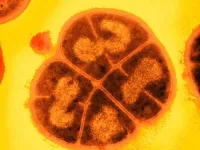(Press-News.org)
Dubbed “Conan the Bacterium” for its extraordinary ability to tolerate the harshest of conditions, Deinococcus radiodurans can withstand radiation doses thousands of times higher than what would kill a human — and every other organism for that matter.
The secret behind this impressive resistance is the presence of a collection of simple metabolites, which combine with manganese to form a powerful antioxidant. Now, chemists at Northwestern University and the Uniformed Services University (USU) have discovered how this antioxidant works.
In a new study, the researchers characterized a synthetic designer antioxidant, called MDP, which was inspired by Deinococcus radiodurans’ resilience. They found MDP’s components — manganese ions, phosphate and a small peptide — form a ternary complex that is a much more powerful protectant from radiation damage than manganese combined with either of the other individual components alone.
This discovery could eventually lead to new synthetic antioxidants specifically tailored to human needs. Applications include protecting astronauts from intense cosmic radiation during deep-space missions, preparing for radiation emergencies and producing radiation-inactivated vaccines.
The study will be published during the week of Dec. 9 in the Proceedings of the National Academy of Sciences.
“It is this ternary complex that is MDP’s superb shield against the effects of radiation,” said Northwestern’s Brian Hoffman, who conducted the study with USU’s Michael Daly. “We’ve long known that manganese ions and phosphate together make a strong antioxidant, but discovering and understanding the ‘magic’ potency provided by the addition of the third component is a breakthrough. This study has provided the key to understanding why this combination is such a powerful — and promising — radioprotectant.”
Hoffman is the Charles E. and Emma H. Morrison Professor of Chemistry and professor of molecular biosciences at Northwestern’s Weinberg College of Arts and Sciences. He also is a member of the Chemistry of Life Processes Institute. An expert on Deinococcus radiodurans, Daly is a professor of pathology at USU and a member of the National Academies’ Committee on Planetary Protection.
Incredible Hulk of the microbial world
The new study builds on previous research from Hoffman’s and Daly’s collaboration, during which they sought to better understand Deinococcus radiodurans’ predicted ability to withstand radiation on Mars. In that research, Hoffman’s team at Northwestern used an advanced spectroscopy technique to measure the accumulation of manganese antioxidants in the microbes’ cells.
According to Hoffman and Daly, the size of the radiation dose that a microorganism or its spores can survive directly correlates with the amount of manganese antioxidants it contains. In other words, more manganese antioxidants mean more resistance to intense radiation.
In earlier studies, other researchers discovered Deinococcus radiodurans can survive 25,000 grays (or units of x- and gamma-rays). But, in their 2022 study, Hoffman and Daly found that the bacterium — when dried and frozen — could weather 140,000 grays of radiation, a dose 28,000 times greater than what would kill a human. So, if there are any slumbering, frozen microbes buried on Mars, they possibly could have survived the onslaught of galactic cosmic radiation and solar protons to this day.
The power of three
Building on their efforts to understand the microbe’s radiation resistance, Hoffman and Daly’s team investigated a designer decapeptide called DP1. When combined with phosphate and manganese, DP1 forms the free-radical-scavenging agent MDP, which successfully protects cells and proteins against radiation damage. In another recent study, Daly and his collaborators found MDP is effective in the preparation of irradiated polyvalent vaccines.
Using advanced paramagnetic resonance spectroscopy, the team revealed that the active ingredient of MDP is a ternary complex — a precise assembly of phosphate and peptide bound to manganese.
“This new understanding of MDP could lead to the development of even more potent manganese-based antioxidants for applications in health care, industry, defense and space exploration,” Daly said.
The study, “The ternary complex of Mn2+, synthetic decapeptide DP1 (DEHGTAVMLK) and orthophosphate is a superb antioxidant,” was supported by the National Institutes of Health (grant number GM111097), the National Science Foundation (grant number CHE-2333907) and the Defense Threat Reduction Agency (grant number HDTRA1620354).
END
A new USC Stem Cell study published in the Proceedings of the National Academy of Sciences (PNAS) has identified key gene regulators that enable some deafened animals—including fish and lizards—to naturally regenerate their hearing. The findings could guide future efforts to stimulate the regeneration of sensory hearing cells in patients with hearing loss and balance disorders.
Led by first author Tuo Shi and co-corresponding authors Ksenia Gnedeva and Gage Crump at the Keck School of Medicine of USC, the study focuses on two cell types in the inner ear: the sensory cells that detect sound, and the supporting cells that create an environment where ...
CLEVELAND (Dec. 9)—A cave in Galilee, Israel, has yielded evidence for ritualistic gathering 35,000 years ago, the earliest on the Asian continent. Three Israeli researchers led the team that published its results today in the journal Proceedings of the National Academy of Sciences.
And researchers from the Case Western Reserve University (CWRU) School of Dental Medicine helped unearth the cave’s secrets over more than a decade of excavation.
Manot Cave was used for thousands of years as a living space for both Neanderthals ...
A collaborative study has uncovered evidence of rice beer dating back approximately 10,000 years at the Shangshan site in Zhejiang Province, China, providing new insights into the origins of alcoholic beverage brewing in East Asia.
This discovery highlights the connection between rice fermentation at Shangshan and the region’s cultural and environmental context as well as the broader development of early rice agriculture and social structures.
The study was jointly conducted by researchers from Stanford University, the Institute of Geology and Geophysics (IGG) of the Chinese Academy of Sciences, and the Zhejiang Provincial Institute ...
December 9, 2024 (Washington, DC, United States of America and Amsterdam, the Netherlands) - The Society for Research in Child Development (SRCD) and the International Society for the Study of Behavioural Development (ISSBD) were recently awarded 200,000 Swiss Francs from the Jacobs Foundation to support initiatives related to mentoring early career scholars from Ghana and Colombia in the areas of grant writing, research methodology, peer reviewing, and scholarly publishing. The grants are part of a larger collaborative project called the ...
LA JOLLA, CA—Imagine an artificial intelligence (AI) model that can watch and understand moving images with the subtlety of a human brain. Now, scientists at Scripps Research have made this a reality by creating MovieNet: an innovative AI that processes videos much like how our brains interpret real-life scenes as they unfold over time.
This brain-inspired AI model, detailed in a study published in the Proceedings of the National Academy of Sciences on November 19, 2024, can perceive moving scenes by simulating how neurons—or brain cells—make real-time sense of the world. Conventional ...
More than half of laws and policies on healthcare workers’ rights align with international standards, according to a study published December 9, 2024 in the open-access journal PLOS Global Public Health by Matthew Kavanagh from Georgetown University, U.S., James Campbell from the World Health Organization, Switzerland, and colleagues.
As the COVID-19 pandemic unfolded, healthcare workers were at the forefront to stem the tide, often putting their own health at risk. Inadequate infection control measures and insufficient access to personal protective ...
University of Houston psychology researcher Jason Griffin, who has pioneered new ways of measuring eye movements to understand autism spectrum disorder, is reporting that children with autism focus on faces differently than other children, especially in the early stages of visual processing. His findings may lead to improvement in face processing for those with the neurodevelopmental condition.
For most people, looking eye-to-eye with someone while talking seems an important yet innocuous social convention – one barely thought of during polite conversation. But for those with autism, characterized ...
The majority of the known asteroids orbit within the main asteroid belt located between Mars and Jupiter at an average distance from Earth of about 250 millions kilometers. Since the discovery of the first asteroid in 1801, nearly 750.000 of them have already been numbered, mainly in the last decade thanks to the many optical surveys searching the sky every clear nights. Most of these asteroids are larger than 1 kilometer, the largest one, Vesta, at about 530 km in diameter, while many millions of smaller ones are expected. While these look huge numbers, the total mass of all the asteroids combined is less than that of Earth's Moon.
Sometimes, these asteroids ...
SAN ANTONIO, Dec. 9, 2024 – Mays Cancer Center at The University of Texas Health Science Center at San Antonio (UT Health San Antonio), in partnership with the American Association for Cancer Research (AACR), is hosting the 47th annual San Antonio Breast Cancer Symposium at the Henry B. Gonzalez Convention Center on Dec. 10-13.
Owned and initiated by Mays Cancer Center, the San Antonio Breast Cancer Symposium is the world’s largest breast cancer research conference. More than 11,000 clinicians, researchers, and patient ...
“This study reveals the potential for prognostic features in predicting hepatic decompensation in patients with PSC.”
BUFFALO, NY – December 9, 2024 – A new research paper was published in Oncotarget’s Volume 15 on November 22, 2024, entitled “Computed tomography-based radiomics and body composition model for predicting hepatic decompensation.”
Mayo Clinic researchers Yashbir Singh, John E. Eaton, Sudhakar K. Venkatesh, and Bradley J. Erickson have developed an innovative AI tool to predict hepatic decompensation in individuals with primary sclerosing cholangitis (PSC). PSC is a chronic disease that damages ...










